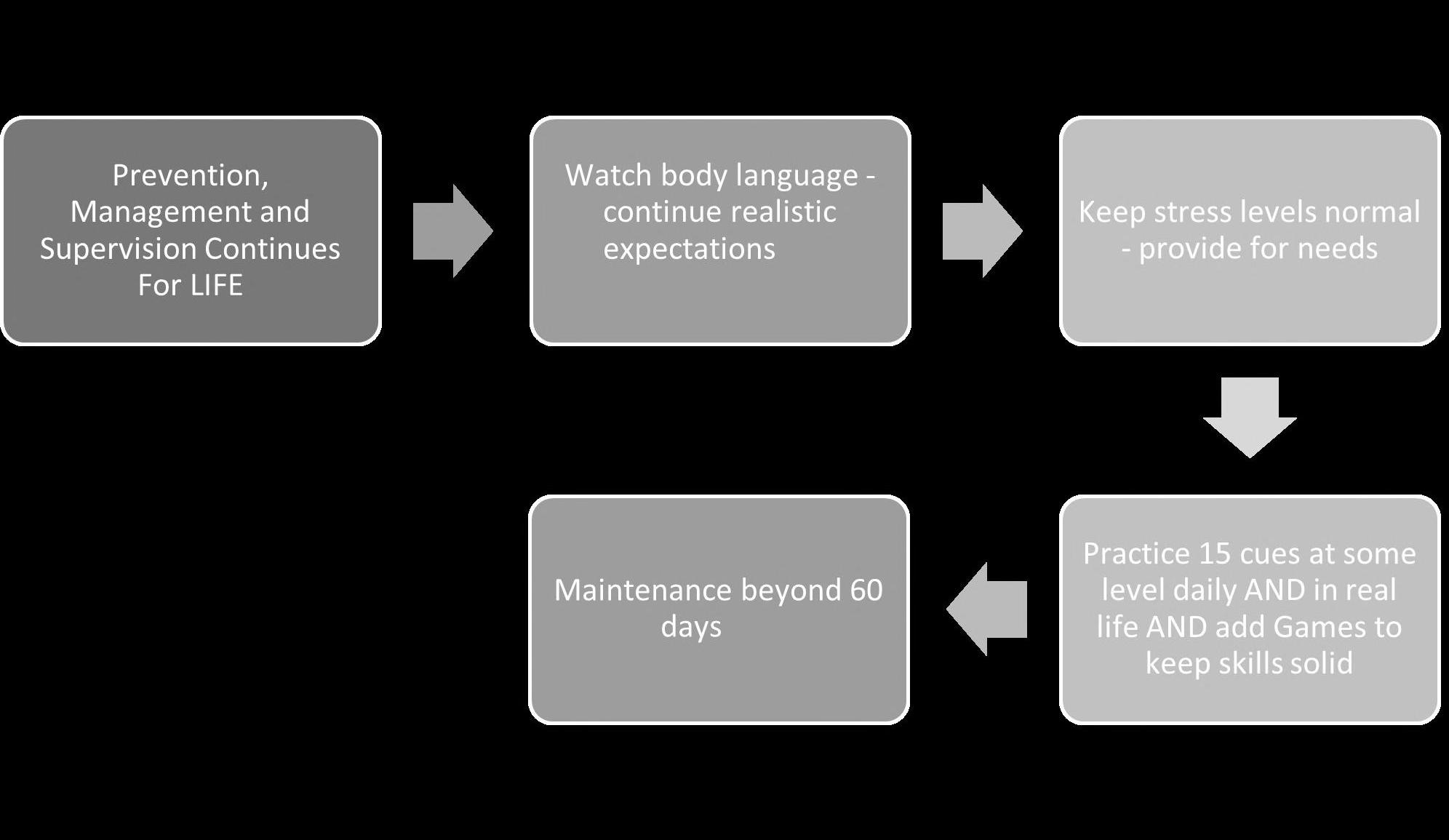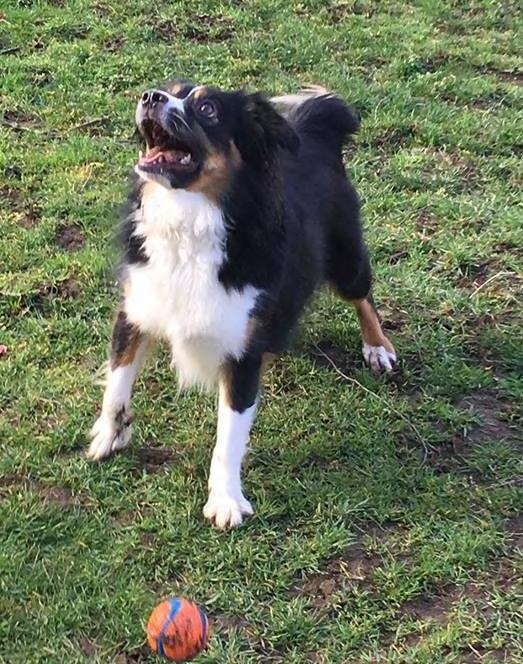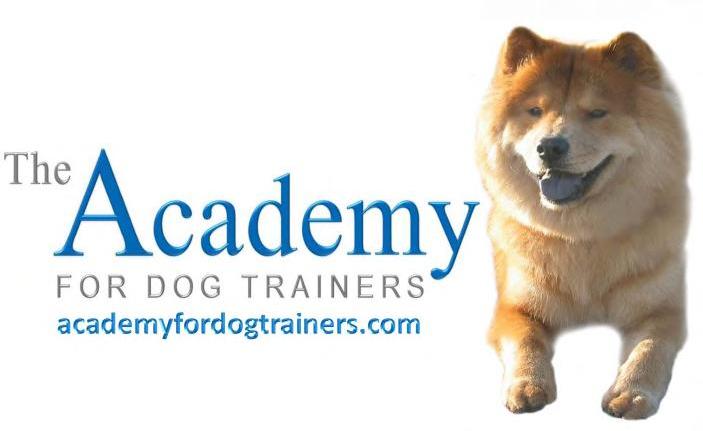
18 minute read
BEYOND 60 DAYS
t r a i n i n g Beyond 60 Days
Diane Garrod outlines five tips and games for dogs who have undergone initial training to take them from resource guarding to resource sharing, that will help both dog – and owner – avoid reverting to old habits
Advertisement
© Diane Garrod The final step, for all dogs guarding a resource of any kind, is that while interested in an object, item, food, or location, they will eagerly and willingly give it up, and share it on cue

This article is a followup article to From Guarding to Sharing (see BARKS from the Guild, March 2021, pp.40‐43), where I set out my process for addressing resource guarding in dogs, including the importance of differentiating the behavior from possessive aggression and avoiding inaccurate labeling.
In my experience, 60 days is more than enough time to turn resource guarding behavior around, so to speak, get strong cue development, and get compliance with sharing high value items. But what do you do beyond those 60 days to keep cues strong, and avoid going back to old habits on both sides of the leash? The focus of this article is to help make sure your cues remain strong and that your plan is resultsoriented for your dog’s entire lifetime.
Prevention, management, and supervision are key to the structure you want, and teaching should not stop suddenly with the belief that the dog is “cured.” All dogs can guard resources; it is normal, natural, and instinctual. Making sure it does not escalate, and that relinquishing a resource is always a positive experience, with reinforcement, is an ongoing mindset. The more a dog is successful with the process and the cues, the more they will share without hesitation.
Going Forward
Let’s start then at the 60day mark, assuming you have read and implemented the recommendations set out in my previous article. By this stage, your dog (even in extreme cases) should have diminished scrounging around for food and items. They will be bringing items to you, including high value items, and laying them in your lap or at your
© Diane Garrod The Find the Resource game engages the SEEKING system and makes finding resources fun, allows for sharing the find, telling the handler about it, and waiting for the release, plus then being responsive to a strong, established cue
feet. You should be able to bend and pick up things like a ball, toy, Frisbee etc. without incident because the reward (and thus the reinforcement) exceeds the trigger.
Here are five tips to keep in mind going forward (see Fig. 1 on p.32 ): 1) Keep cues strong; use them often in training and in real life. 2) Keep prevention, management, and supervision at the top of your task list. 3) Regressing? Go back to kindergarten (i.e. the initial training steps). You will progress faster, and this routine will become the default for the dog. 4) Progress? Highly reward everything the dog does right, always. You want to make the point that a good decision will be highly rewarded. You want to take away the dog’s urge to even feel like they need to guard a resource. 5) Watch the dog’s body language. Know what you are seeing; do not assume.
Cues for Practice
Next, practice the 16 cues listed below, starting with three cues per day, five times a week, for one to two months past the 60day mark. You will know when the dog is fluent in their understanding of these cues by the way they respond to them, and to you, even with high value resources. Then select two cues per day in the third month post the 60day mark, and practice in real life until you are doing some quality reminder work once a day. Thereafter, work first with the weaker cues, and once in a while, the strong cues (so they stay strong).
The 16 cues are as follows (these are the same cues, in order, that were worked on in the first 60 days (again, see From Guarding to Shar‐ing): • Name Responsiveness • Come • Eye Contact • Drop • Get It, Bring It • Take It • Down • Stay • Mat • Come Away • Get Back • Let’s Go • Target/Touch • Off • Up • Move Over
Note: a 17th cue could be added, such as an emergency recall or whistle recall.
During this 16cue process, always evaluate where the dog is on their journey from guarding to sharing. To help with this, let’s now look at what sharing actually looks like.
For food bowl guarding, you will see a dog who continues to eat (vs. eating faster while lowering their head into the bowl and showing whale eye) comfortably, calmly, and with little resistance to approach. You can treat/retreat, and walk away. Eating should always be pleasant for the dog and there should be no violation of trust that the food will be removed. For chews, objects, toys, etc., the dog should start to show little to no worry about sharing the item with you.
All this progresses to the dog feeling extremely comfortable eating no matter what is going on in the environment, and more frequently sharing an object, toy, or even a bone – especially when using a cue such as “get it,” “bring it,” or “drop it.”
The final step, for all dogs guarding a resource of any kind, is that while interested in an object, item, food, or location, they will eagerly and willingly give it up, and share it on cue. In dogtodog resource guarding, there is no longer any reason to compete for resources and dogs can happily enjoy a resource without fear it will be taken away by another dog. Location guarders should be moving over on cue, and when asked to move, doing so eagerly.
Here are five training games that will help you get to the threemonth stage in the teaching process:
Days 61 to 68: Game 1 / Find the Resource
Set‐up: 50 treats to set up a trail and a bowl with a resource at the end (you decide whether low, medium, or high value).
Purpose: To use the SEEKING system to find the resource at the end of the trail; to use one of the above cues, or an alternative cue like sit, when the dog has found the resource (so sit/wait, and release). The find would be much like that in nose work, where the dog must alert you to the find and either gets a trade for the resource, or is released to take it. This game makes finding resources fun, allows for sharing the find, telling you about it, and waiting for the release, plus being responsive to a strong cue you have established.
How‐to: Set up a trail of treats around the house or yard with each one about 35 feet apart. Set a cone up at the beginning of the trail. The dog does not watch you do this and is only introduced to the trail starting at the cone. Set up a bowl with a resource in it at end of trail (it can be hidden under a bush, behind a tree or elsewhere). As you see the dog about five treats away, cue a sit or down/wait and then release or toss a high value reward away from the resource, then pick up the bowl.
Alternatively, release the dog to get the resource and then use one of the cues (a strong one) to have the dog move away, leave, or share
Fig. 1: Beyond 60 Days – A Results-Oriented Approach to Sharing vs. Guarding

© Diane Garrod
the resource. High value rewards must be used.
Maintaining progress for the dog’s lifetime is key (dogs really have such short lives after all, don’t they?). So, breathe, but do not assume anything and do not go back to your old habits or let the dog go back to theirs. Monitor, monitor, monitor.
What should you be seeing? The dog should be showing a good deal of selfcontrol now. Their stress levels should be normal; any spikes should come down quickly. The dog is responsive and pays attention to your cues.
Dogs resource guarding from other dogs should be able to retrieve a ball without guarding it and return it, sharing the toss away from you (two dogs, two balls or items; three dogs, three balls or items etc.). Each dog takes a turn getting the item, bringing it, dropping it, and waiting for their turn again. If you are not seeing the above, go back a bit and work more on these skills.

Days 69 to 75: Game 2 / Tug – Take It, Tug, Drop It, or Release It (Sharing at Its Finest)
Set‐up: A tug toy and the jackpot – a bowl with high value reinforcement or another resource set up on a table or shelf out of reach.
Note: You should have a strong “take it” and a playful tug play for sev‐eral seconds, and a solid “drop it” or release into your hands. If you do not, simply use this game to practice first.
© Diane Garrod The Get It, Bring It, Drop It Game makes it fun for the dog to find, bring and drop an item, and strengthens these cues for when you need them most Purpose: To keep the take it and drop it cues strong and highly reinforced. And to cue the jackpot. After playing the game five to 10 times, the dog understands there is always a larger reward at the end. Also, to chain several repetitions together working toward the larger jackpot!

How‐to: Cue the dog to “take it.” Click/treat 10 times and end. When that is strong, just try a oneoff tug, click/treat and so on. Then, practice the cue “drop it” and click/treat. The click itself should end the behavior and the drop should be easily done. This game should be individualized to where each dog is in the beyond 60 days journey.
A session would be five to 10 trials depending on the dog. Less, possibly, if the dog is an extreme resource guarder. Alternatively, just practice individual elements of this game and then chain them together once they are strong and solid. This will further help the dog that guards resources to understand there is a motivated reinforcement at the end, which makes you worth listening to.
Enrichment and mentally tiring activities should be a daily thing and a good opportunity to practice and keep cues strong. Physical exercise that is stressfree is also needed to keep the dog fit.
Know the signals your dog gives to show they are getting aroused, so you can abort what you are doing and keep them at normal stress levels to avoid any regresses to old behaviors due to overarousal.
What should you be seeing? The dog should be making good decisions by now and automatically using all that you have taught, and responding when a cue is given once.
Location guarders should be sharing space with housemates and have very solid “move over” and “off” cues. These remain highly rewarding, so that guarding a location is not as reinforcing as not guarding a location.
Scrounging for food should be almost nonexistent or rare over two and a half months. With extreme cases, you must take that full three months, with a clear daily work plan so that progress is consistent, and reinforcements outweigh implementation of any guarding behaviors a dog has developed.
By 73 days you should be able to start trusting your dog around resources and vice versa. You are using only forcefree training and the 3Rs: Removal (of yourself, your reinforcements, or the dog, or all three); Redirecting quickly; or a Relax period with something to release stress (or a combination of all the 3Rs). Focus on what the dog is doing right and reinforce those behaviors highly.
What if you have a regress? If a dog loses focus, you have taken them over threshold and could have a regress. Stop what you are doing long before your dog is no longer able to concentrate because he will most likely react and default to old behavior rapidly.
Around this time a regress might well occur, especially with dogs who guard resources from other dogs. As dogs progress, guarding of resources has changed and so they might try to resource guard something else (i.e., a house brother gets too close while the dog who guards resources is putting on their harness, and a treat is being offered).
Watch for these incidences and prevent, manage, and supervise. These are just trigger cues to you and where your work needs to progress and continue. Relationships take turns. And while the housemates are still civil and good friends most of the time, review any incidents (antecedents and consequences), then restructure and proceed.
Days 76 to 85: Game 3 / Hide and Seek the Resource (vary with low, medium, high values)
Set‐up: A handful of treats to sprinkle leading up to one resource and then around the resource; can play indoors or outdoors; use one resource.
Purpose: To let the dog use his nose and activate his tracking skills, but also to satisfy finding a resource and being happy, even eager, to share it with you. Also to practice one of the cues above to allow you to hone your skills of removing the resource. How‐to: A session would comprise one resource and one find to keep the dog successful and wanting to play the game with you again later. Set out a resource of your choosing and at your confidence level with your dog’s progress to this point. Like in Game 1, set up a start cone, sprinkle treats near the cone, and then lay a pathway to the hidden resource. You can just let the dog find the resource and then practice one of cues above.
Alternatively, as in Game 1, have them sit or down/wait to indicate a find and then toss a treat away from the resource and pick it up (or release and reward them with the resource) and then cue and reward one of the 16+ strong cues you now have available. This not only works your dog’s continued love of finding resources and sharing them with you, but your skills in knowing when and how to use each cue.
By this stage, you will be wondering if your dog ever guarded resources at all. Behavior modification progresses if done on a daily schedule. You have progressed from the dog displaying automatic behavior to triggers becoming irrelevant.
What should you be seeing? Around days 85 to 87, you are close to three months (that 90day mark) and extreme resource guarding results should be quite evident (e.g., a dog who intensely – and maybe even vi

© Diane Garrod Practicing the Drop It cue as part of the process to train dogs that it is worth their while to relinquish a resource
ciously guarded an item such as a sock – will now not be very interested because not guarding is the more reinforcing option).
Days 88 to 90 (3 months): Game 4 / OntheRoad Resource Find
Set up: Basically, you hide 510 resources on a walk (whatever that means to your dog), so the setup is to choose a ½ to 1mile walk that is preset with resource hides that have been made just 1015 minutes before you take your dog on this walk. You will need high value rewards as you will be in an open environment. Take a backpack or bag to put the items in once found and remember your cue for the dog to share or pick up an item.
Purpose: This is especially important for dogs who guard any resources they find on a walk, either on or offleash, but can be used with any resource guarder just for fun. This game helps dogs become satisfied with the fun of the hunt, the find, and that it is fun (no matter where they are) to play the cue games with you. Choose one to five cues you will use on this walk with each resource. This helps with focus, activating the SEEKING system, and cue development and strengthening in various environments, plus it makes walks fun and satisfying, and keeps your cues strong when needed most. There are after all, two parties in training here.
How‐to: A session would be one ½ to 1mile walk comprising five to 10 finds. Pre set out a resource of your choosing and at your confidence level with your dog’s progress to this point. You should be able to have your dog happily sharing all the resources or move away from them so you can pick them up. You should have all resources in your possession at end of walk. You can space the resources to find a few on the way out and a few on the way back by strategically placing them across a road, for instance.
What should you be seeing? A dog who guards resources should not be whiny, nor should they any longer be lunging, barking, worrying or anxious. They should be highly responsive to cues given once and eager to play the cue games you have taught them.
At the 90day mark, go on more outings, expand the dog’s horizons and behavior modification work in new environments. At this time, residual behaviors like scrounging, one dog guarding from another dog etc. should be few and far between. The dog has learned new cues and the humans have developed new, more productive habits in working with their dog to avoid resource guarding. Now, working beyond the home environment is the goal over the next three months, while keeping all cues strong and in place at home and in the yard.

3 Months and Beyond: Game 5 / Three Cup Search and a Game of Fetch (Get It, Bring It, Drop It)
Set‐up: Three cups; treats to hide under the cups; a resource to get, bring, and drop. High value reinforcers (like meatballs or other stinky food that your dog will work for); a backpack to carry items in to make a stop, or stops, along the route to play the game.
Purpose: To enjoy a walk and stop to set up a game of Get It, Bring It, Drop the Resource. You can set this up once on your walk or several times. It makes it fun for the dog to find, bring and drop an item, and strengthens this cue for when you need it most.
How‐to: A session would be done on a normal walk. Simply stop on your route, take off your backpack, and set up the game. Do this by setting the cups in a row, about 1 ft between them, and hide the treats underneath. Next, set up a resource by hiding it about 10 ft away from the cups. The dog should be on a sit or down/stay (if strong), or you can loosely tether them a picnic table or tree for the short setup period. Onleash, release the dog to find the treats under the cups first, then ask the dog to find the resource – without creating a path to it.
Use your cues (as the dog gets close) Get It, Bring It, Drop It, then click/treat with your high value reinforcer. Reinforcers can be tossed to the far right or left, or up and over the dog’s back as you bend down to pick up the resource. End on success and pick up the items, pack them away and continue your walk. Note: You can play this anywhere but try taking it on the road at least every third time.
It is amazing how little time forcefree training takes and, with the support of a systematic plan, how much and how well dogs retain the information they learn, how their behavior changes progressively, and how they transform. Eventually, regresses should be far between and few. You have established 16+ cues and practiced them in planned sessions and in real life. You now are beyond 60 days with your training and practicing these five new games will strengthen your cues even more, not only making it fun for your dog to relinquish resources, but also fun for you as you establish a more sharing relationship. n
References
Garrod, D. (2021, March). From Guarding to Sharing. BARKS from the Guild (47) 4043
Diane Garrod BSc PCT-A CA1 FF1 is the owner of Canine Transformations based in Langley, Washington, where she conducts Treibball workshops, classes and private consults, specializing in canine aggression and reactivity.











